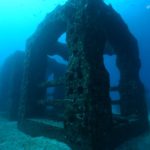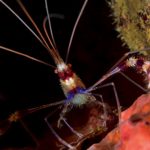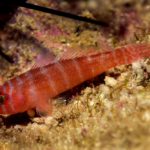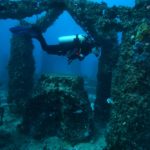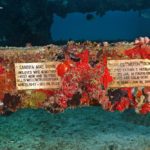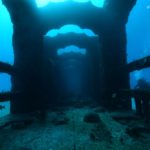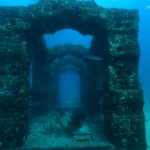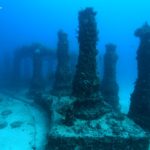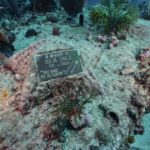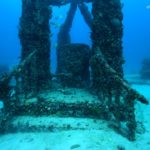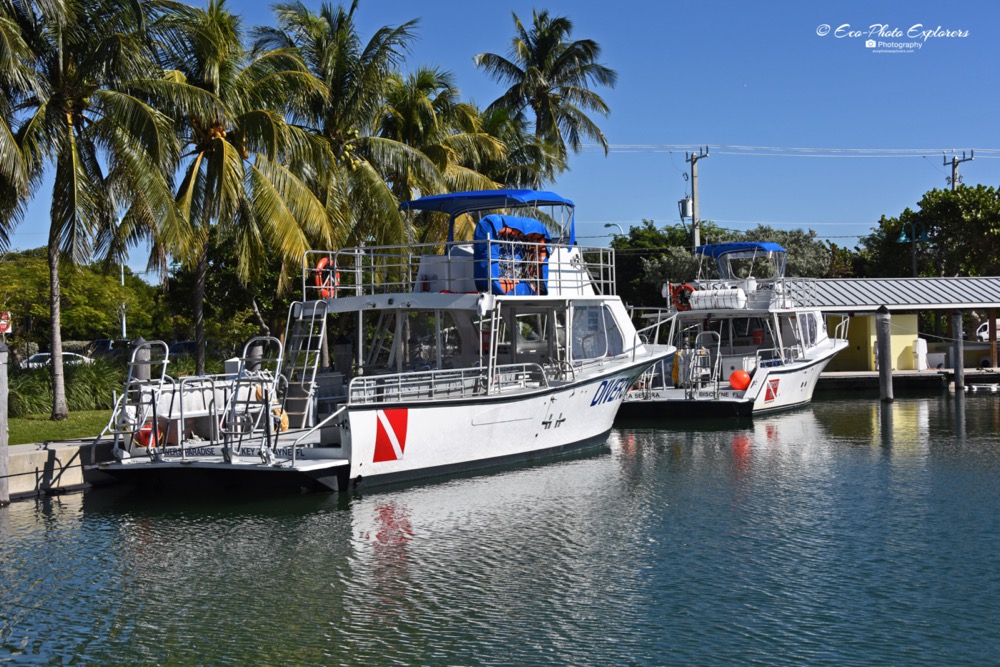
Divers’ Paradise has the closest dive boats to the Memorial Reef
The warm waters off Key Biscayne in Florida are home to coral reefs and historic shipwrecks. Within site of the famous Miami skyline, divers here can encounter colorful marine life and robust populations of reef fish and with the combination of clear waters, healthy reefs and sunken history, it seems as if there is a little something here for everyone.
And that includes taphophiles.
Before you go and Google wat that is, a taphophile is defined as a person who is interested in cemeteries, funerals and gravestones. By now, you are wondering “what does this have to do with SCUBA Diving?”
Located just 3.25 miles off the coast of Key Biscayne is the Neptune Memorial ReefTM , designed as an underwater columbarium to cover 16 acres of ocean bottom. First opened in 2007, the site, which features man-made structures resembling the Lost City of Atlantis, is sometimes referred to as an underwater mausoleum or underwater cemetery but it is neither. Because cremated remains are mixed with reef building materials and then installed onto the structure, a more accurate description is that it is a cremation memorial site.
And it is open to divers.
Diving on a memorial site might sound morbid, but the Neptune Memorial ReefTM is designed rather as a celebration of life. The project is environmentally sound and meets the strict guidelines and permitting of the EPA, DERM, NOAA, Florida Fish and Wildlife and the Army Corps of Engineers. The Neptune Memorial Reef™ is certified by the Green Burial Council.
Words & Photos by Michael Salvarezza and Christopher P. Weaver
Neptune Memorial Reef™ is designed to be constructed over time and in separate phases. The first two phases of construction included 76 columns covering a half-acre of ocean floor. When complete, the Neptune Memorial Reef™ is planned to cover 16 acres and will include over 5,000 columns. The building cost for the first phase of the Reef was over $1.5 million.
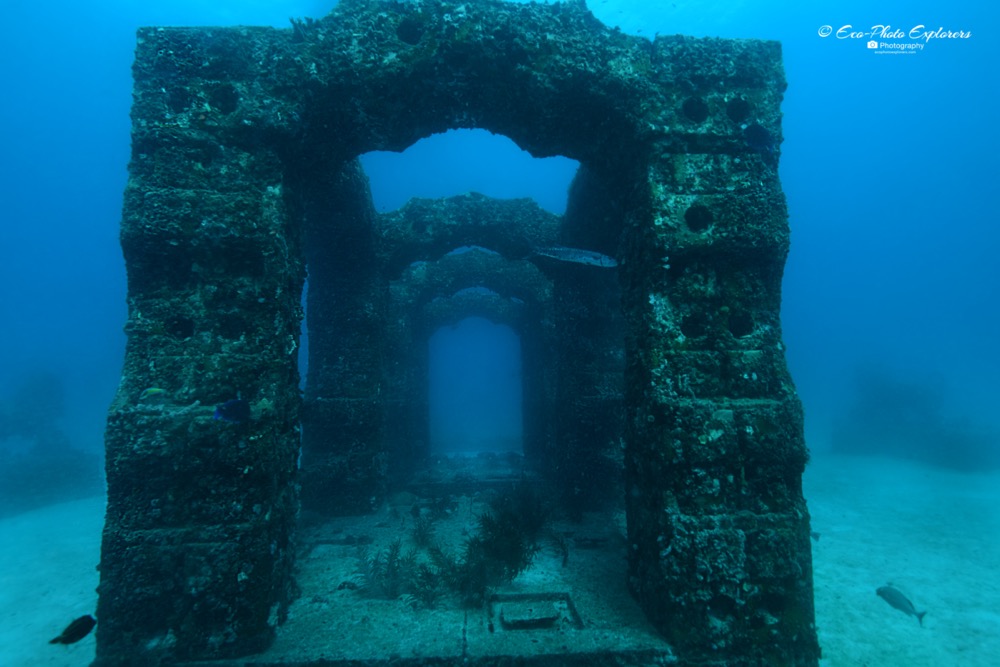
The first two phases of construction included 76 columns covering a half-acre of ocean floor
One of the requirements of the permitting process was that the reef be built to withstand the strength of a 100-year storm. Accordingly, custom-built molds are used to create columns, arches, and bases from steel reinforced concrete. Each concrete base, the smallest of which weighs 50 tons, has four 8-inch pipes that extend eleven feet into the sand to prevent unintended movement of the Reef.
The first remains placed on the reef were cremated remains that unfortunately had been abandoned by their families. The first “intended” placement were the remains of Daniel Restrepo who died 10 years after surviving a drive by shooting at the age of 13.
It is anticipated that when the entire reef is completed, more than 250,000 memorials will be accommodated on the reef.
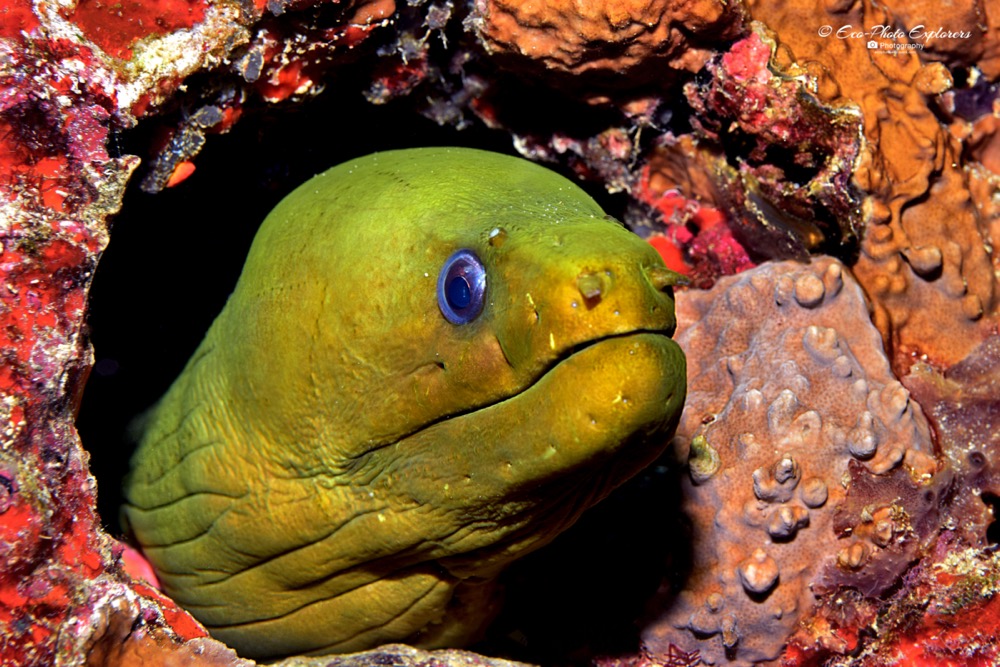
This Green Moral Eel is keeping watch over the memorial reef
So how does all of this work?
Some customers arrange to have the cremated remains mixed with concrete and other materials, which is then used to create the structures of the reef. Others arrange to have structures in the shape of marine creatures created out of this mixed material, which are then installed onto the reef in various locations. Once the remains are placed on the reef, a memorial nameplate is installed to memorialize the life of that person.
Diving on the reef is an oddly joyous and inspiring experience. Situated in 40 feet of water, the site is accessible to divers of all skill levels and because of the good visibility often found here, the massive structures are even visible from the surface for snorkelers.
On our dive, we first descended to the center of the reef, where we swam above what is designed as an altar. Here, surrounded by columns arranged in a semi-circular pattern, we gazed upon several memorial plaques documenting the names and lives of various individuals whose remains have become a permanent part of the reef. Some have chosen a simple approach while others have included inspirational or, in some cases, humorous statements to go on their final nameplates.
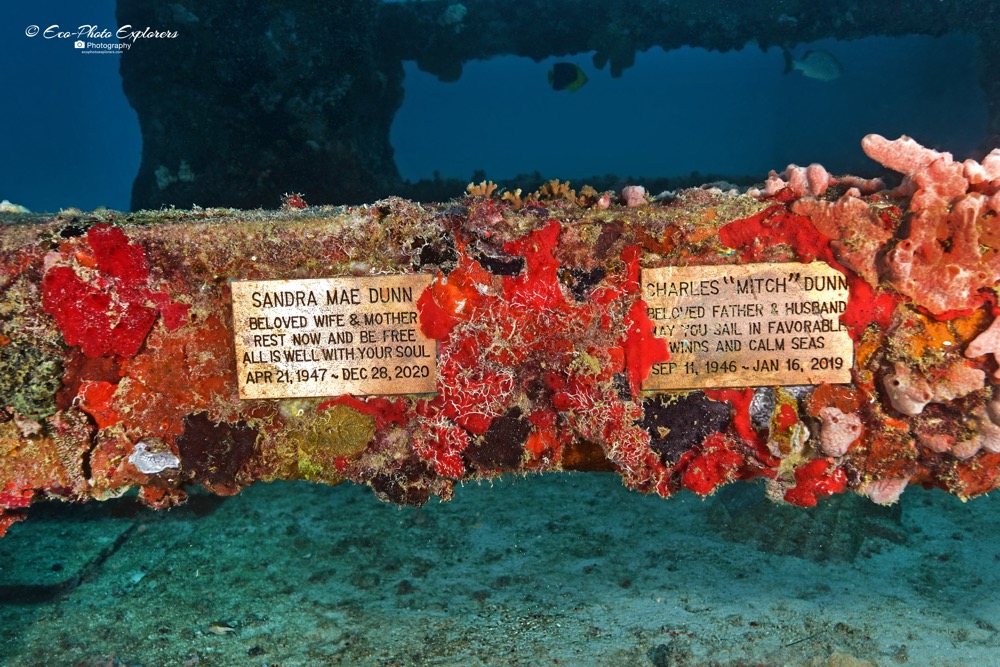
Divers can read the inscriptions and reflect on the lives of those interred on the reef
Phase 2 of the reef was built with a number of large, cube shaped structures lined in a row extending from the center of the reef. More marine life figures and more nameplates could be seen in and around the structures. Along the way, it is hard to avoid stopping and reflecting upon the lives represented by the various nameplates. The reef is a place of reverence and reflection.
Because more than 14 species of coral have taken up residence, the Neptune Memorial Reef™ can be accurately described now as a living reef. As we explored the structure, we encountered large schools of grunts and snapper, along with several large Green Moray eels and other reef inhabitants more commonly found on the offshore reefs. As we peered into some of the pre-fabricated holes in the structures, we spotted Arrow Crabs, Banded Shrimp and small gobies delightfully tucked securely away from predators.
Indeed, the reef is fulfilling its purpose both as the final resting place for a growing number of people, and as a thriving marine habitat rich in marine life.
This artificial reef is now a living memorial to those whose passion for the sea and connection to the marine world led them to choose this as their final resting place. In many ways, this is the ultimate form of giving back as many are contributing to the construction of a healthy marine environment by arranging to have their remains become part of these sunken structures.
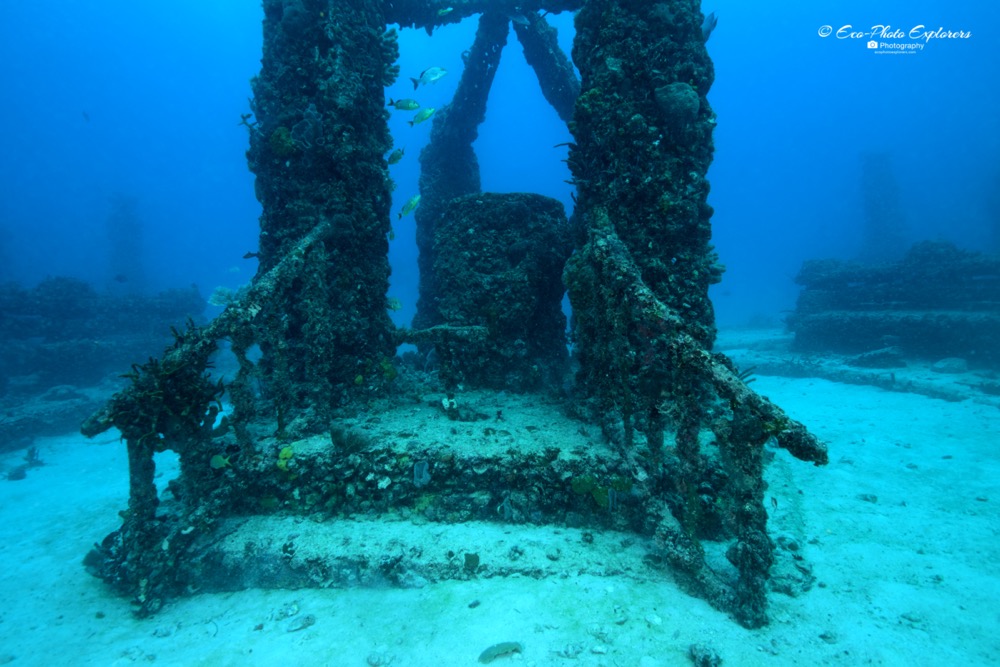
The reef resembles the lost City of Atlantis
We were happy to have experienced this special site and to visit with some of those who decided to give back to the ocean as their final wish.
The Neptune Memorial Reef™, while one of the largest and oldest of these reef structures, is not alone. Memorial reefs exist in several other parts of the world. Many of these reefs consist of basic concrete reef balls, which have the cremated remains mixed in and a plaque attached to honor the deceased. The Neptune Memorial Reef™ is, perhaps, unique though in its artistic rendering of the Lost city of Atlantis.
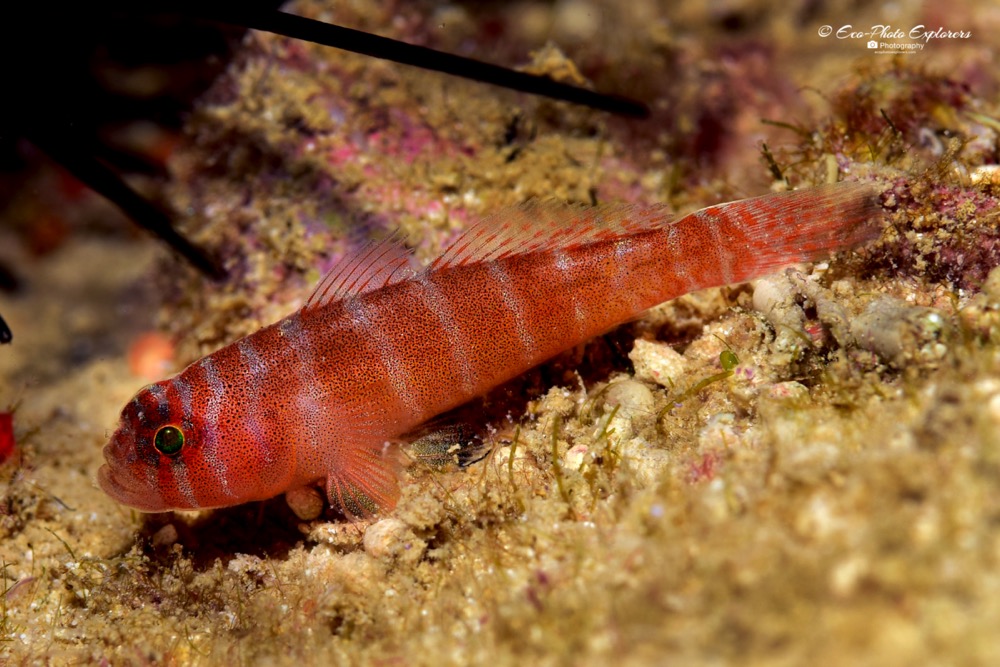
This tiny Goby was photographed under the spines of a sea urchin
There are a number of dive operations that take divers to the reef. The closest is “Divers Paradise”, located right on Key Biscayne. When diving the reef, remember that this is an actual working memorial. Treat the reef with respect and reverence for those who have found final repose here. Regardless of your interest, the Neptune Memorial Reef™ is a unique and special dive site. And given the growing popularity of underwater memorial sites, and the unique benefits they provide, perhaps there is room for a new specialty certification: Taphophile Diver!
Words & Photos by Michael Salvarezza and Christopher P. Weaver
- A juvenile Spotted Drum is part of the ecosystem on the reef
- This tiny Goby was photographed under the spines of a sea urchin
- Divers’ Paradise has the closest dive boats to the Memorial Reef
- Look into the crevices to find Banded Shrimp
- Internments on the reef can be marked with sculptures of marine life
- This tiny Goby was photographed under the spines of a sea urchin
- Divers experience the serenity of swimming through the memorial reef structure
- The Cape Florida Lighthouse stands tall at the south end of Key Biscayne
- Divers can read the inscriptions and reflect on the lives of those interred on the reef
- The Four-eye Butterflyfish uses its prominent spot to distract predators
- In just a few years, the memorial reef has attracted a wide variety of marine life
- This Green Moral Eel is keeping watch over the memorial reef
- The Neptune Memorial Reef is a tranquil final resting place for lovers of the sea
- The first two phases of construction included 76 columns covering a half-acre of ocean floor
- The reef columns lie in 40 feet of water
- A gathering of Blue-striped Grunts seek shelter on the memorial reef
- Julie Child’s remains are on the reef
- The reef resembles the lost City of Atlantis


